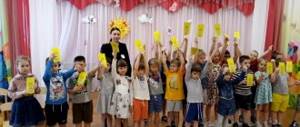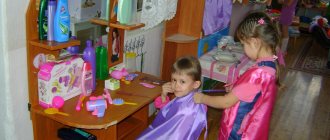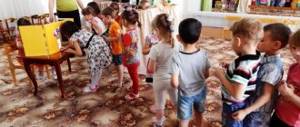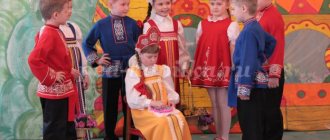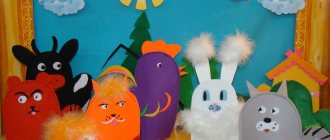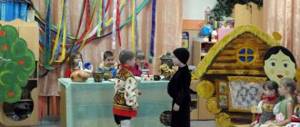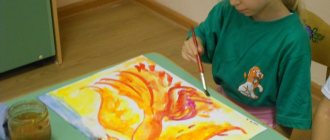Conversation in kindergarten with preschoolers 5-7 years old about theater
Conversation for children of senior preschool age about theater
Description: This conversation is intended for preschoolers aged 5–7 years and is conducted as part of the study of the lexical topic “Theater” during theater week at a preschool educational institution Purpose : acquaintance with the theater, cultivating interest in it. Objectives : • To introduce children to the theater, the history of theater, types of theater • To introduce children to theatrical professions • To introduce children to theatrical culture
The history of the theater.
What is this beautiful building with columns that looks like a palace?
This is a theatre. This theater is a magical house!
You will see a fairy tale in it. Dancing, music and laughter - a performance for everyone! The word "theater" is of Greek origin.
In Greek it meant the place for the spectacle and the spectacle itself. The art of theater arose a long time ago and developed along with the life of humanity itself. One of the main elements of theatrical art is acting. It all started with her. The infancy of the theater became the games and rituals of primitive peoples. In these games, the first “characters” appeared - good and evil forces. They were expressed not by people, but by deities, spirits, natural phenomena, the meaning of which people did not yet understand. Magic was considered one of the most important means of achieving success in business. It consisted in the fact that before any action or work, a mimic scene was played out, depicting the successful implementation of this process. Participants in ritual games used complex pantomime, accompanying it with music, dances, and songs. Ancient Greece can be considered the birthplace of the theater. Ancient theaters were open and reached enormous sizes; they could accommodate up to 44 thousand people. Actors were held in high esteem in Greece. They had to be able to sing, dance, and master the art of speech. In Russia, as in other countries, the emergence of a national theater is associated with folk games and rituals. The first steps of the Russian theater are also associated with various rituals. So, before a hunt, the ancestors of the Slavs performed special dances. And the most fun were the pre-spring holidays: it was necessary to appease the deity so that it would wake up earlier, then the harvest would be richer. And the only way to appease him was with fun, jokes, and laughter. In all these rituals, games, and holidays, people began to stand out, whose ability to sing, dance, joke, play musical instruments, and tell fairy tales attracted everyone's attention. So in the 11th century, buffoons appeared in Rus' - wandering actors and comedians. For several centuries they staged their performances right on the streets, squares, and fairs. They acted out little funny scenes of their own composition, sang funny songs, showed acrobatic acts and trained animals. The main character of buffoon performances is a cheerful and dexterous man who always knew how to outwit the evil and stupid master. Buffoons were traveling performers. Performances with a scientist bear – “bear fun” – were very popular. There was no permanent theater in Rus' at that time. Such a theater opened its curtains in Yaroslavl. Its founder was our fellow countryman Fyodor Grigorievich Volkov. Fyodor Grigorievich Volkov was born on February 20, 1729 into a merchant family in Kostroma, and from the age of 10 he lived in Yaroslavl. He was smart, observant, hardworking, loved books, music, composed songs himself, played the harp, loved to participate in home performances. As a young man, while studying at the Moscow Academy, he devoted all his free time to his favorite hobby - theater. Returning to Yaroslavl in 1749, Volkov created a theatrical drama troupe and staged performances in an ordinary barn; later a wooden theater was built. Many people came to watch the performances and admired the talent of the troupe. The fame of the Yaroslavl theater reached the capital, the Empress Catherine. In January 1752, Volkov's troupe, by decree of Empress Elizabeth Petrovna, was summoned to St. Petersburg, where the Yaroslavl residents gave several performances at court, as well as public ones, after which the four best actors were left in the capital, including Volkov and his brother Grigory. The two of them were assigned to the court theater. On August 30, 1756, a decree was issued on the establishment of a permanent “Russian Theater for the Presentation of Tragedies and Comedies.” Playwright A.P. Sumarokov was appointed director of the theater, whom Volkov first helped in managing the theater, and then replaced him. Volkov had many talents: he was a wonderful actor, poet, painter, musician, sculptor. Our theater is the first national theater in Russia. It is called in honor of its founder: the Academic Drama Theater named after Fyodor Volkov. Types of theater The theater is an amazing place where performances are shown, music is played, poetry is read, where people dance and sing, where you can laugh and cry, where there is something to think about and be surprised by. Sometimes it can be scary, but more often it’s fun. The theater was created for spectators to come and watch performances. Theater is a special art. There are different theaters. There is an opera and ballet theater, where the main thing in the performance is music. In an opera (musical and dramatic performance), for example, opera artists do not speak, but sing arias. The voices of opera singers are very beautiful and clear. But in addition to his voice, an opera artist also needs acting skills - after all, this is not just a concert, but a whole performance with its own plot. In opera, it is important not only what the singer sings, but also how he does it, what feelings he conveys to the audience. How is an opera created? First, a literary work is selected, for example, a fairy tale. Based on it, a libretto is written - a text - the basis for the future performance. The composer composes music, the singers learn their arias. An opera can have an aria by one singer, a duet when two people sing, a choral performance by many artists, or simply musical inserts. All this adds up to a performance. The combination of beautiful music, beautiful voices and a beautiful story - isn't it great! In our time, the world's first musical theater for children was created in Moscow. It was founded by Natalia Ilyinichna Sats. She staged the operas “Morozko”, “The Wolf and the Seven Little Goats”, “Three Fat Men”, “The Giant Boy” in the theater for children... There is an operetta theater. Operetta is a cheerful performance with music, songs, fiery dances, and witty dialogues. Ballet art is a type of theater where the content is conveyed to the audience without words: through music, dance, pantomime. The word "ballet" comes from the Latin "to dance". The creation of a ballet performance begins with the author writing a libretto - a script for the future performance, a summary of what the audience will see. The libretto sets out the plot, telling what events and with which characters will take place on stage. Then, based on the libretto, the composer writes music. Then the choreographer - the ballet director - gets down to business. The roles are assigned to the dancers. All together they create a performance and dance. The ballet dancers talk about all the events and the characters’ relationships with each other through dance. To create a certain mood, atmosphere, scenery, scenery created by artists is used. The costume plays a special role in ballet: it should be light, comfortable for dancing, and beautiful. Do you know how many ballets have been staged based on fairy tales? “The Nutcracker”, “Sleeping Beauty”, “The Little Humpbacked Horse”. The dancers convey a variety of feelings with their movements, and the audience is happy and sad along with the characters, just as if they had heard them speak. And in dramatic theater the main means is the word. It is no coincidence that drama theater is sometimes called conversational theater. The word "drama" in Greek means "action". A drama or play is a special text that is written to be shown to spectators or the public in a theater. There are no descriptions in a drama, like in a story or a fairy tale. The playwright - the writer who composes the drama - talks about the characters and events in dialogue, conversation. If a play were written about us, the playwright would include us in the list of characters, and then put our conversations - dialogues - into the play. There are different types of dramatic performances - comedy, tragedy, melodrama. Comedy is a funny performance, tragedy is serious and sad. After all, there are not only joyful events in life. And the tragedy makes people think. Melodrama is a play in which sad events occur, but everything ends well - good heroes become happy, and evil ones get what they deserve. Which theater is the most unusual? There are many such theaters. For example, the theater of animals. There are animals performing there. The roles in the play are played by cats, dogs, mice or even elephants. There is another theater - a puppet theater. We all know the fairy tale by Alexei Nikolaevich Tolstoy “The Golden Key, or the Adventures of Pinocchio.” It tells about the adventures of the wooden doll Pinocchio. And the fairy tale ends with a performance at the Molniya puppet theater, where the puppets themselves write plays in verse and act in them themselves. Puppet theater dates back to ancient Rome. Gradually, puppet characters appeared in many countries. In Italy, Pulcinella became the audience's favorite, in France - Polichinelle, in England - Punch, in Russia - Petrushka... On the modern stage of a puppet theater, puppets can play together with actors. This is a wonderful theater, and there are all kinds of puppets there. There are riding glove puppets (the artist puts them on his fingers like a glove, while he hides behind a screen), there are puppets on strings (the puppeteer controls them from above, pulling first one string, then the other. Puppets of this system are often called puppets, but this is incorrect , because in many countries any theatrical puppet is called a puppet), cane puppets (they are held by a stick that passes through the entire doll. The actor controls the doll’s hands with the help of thin sticks - canes, which are hidden from the viewer in the sleeves or in the doll’s clothes), mechanical, shadow... In the theater, the shadows of the puppets are not visible at all, only their shadows are visible. The main puppet theater in our country has become the Central Puppet Theater in Moscow, its creator and director is Sergei Vladimirovich Obraztsov. There are all kinds of theaters, and what they don’t have! Here they will perform performances for you, Drama, opera, ballet. Here on stage you can meet various dolls and animals. Children love the theater very much, so let's go there soon. Theater building The theater building is home to magical performances. A modern theater building is full of technology, electronics, and optics, like a large industrial enterprise. And the theater building began with a simple open area, as it was in the ancient Greek theater. Much later, in the 17th century, the “theater building” of the buffoons - puppeteers - was contained in a piece of brightly painted canvas. In the middle of the square at the fair, an actor-puppeteer appeared in strange clothes: dyed dye hung around his waist almost to the ground - something like a skirt. The actor raised his arms and the raised “skirt” covered the entire upper part of his body. And then, above, along the edge of such a homemade screen, dolls appeared and acted out their stories. Sometimes theatrical performances were performed right in the squares. Today, only a team of specialists can service the complex structure of the theater, especially the stage. Of particular importance in the design and construction of theater buildings is their acoustics - creating the best audibility from any place. This is what acousticians do. Here is the hall. There is a theater curtain on the stage. It opens only during the performance. Curtains are of great importance: there is a fire-resistant iron curtain, which separates the stage from the auditorium if necessary, a lowering intermission curtain, a sliding intermission curtain, and a muffler that absorbs various unnecessary noises. There is a huge beautiful chandelier in the hall. During the performance, the lights in the hall are off, but the stage is illuminated. There are spotlights at the top. There are many of them in the hall, both on the sides and above the stage. They illuminate the stage and actors with rays - sometimes muted, sometimes bright, sometimes white, sometimes colored. The stage is the main part of the theater building, a platform for actors to play. The stage is the part of the theater building where the performance takes place. "Scene" is a Greek word. In the ancient Greek theater, it was a light building where the actors changed clothes and came out from. And they played in the orchestra - a round or semicircular open space in front of the stage, in the open air. Later, the place for the actors to play became a platform formed by a high decorative building in front of the stage. In the ancient Roman theater it occupied most of the orchestra and became known as the proscenium. From this the modern scene developed. Everything is here. And the underground kingdom, where complex mechanisms are hidden, is called the hold. Holds vary in depth depending on their purpose. Here, for example, the hero of the play can, if necessary, fall through the ground. The floor of the stage - the tablet - consists of individual boards measuring 2 * 1.5 meters. The hold and tablet make up the lower stage. There are also sky-high heights where grate bars, gratings, and lifting devices for decorations are located. A wizard, Baba Yaga, can ascend into this theatrical sky... The modern stage is a stage - a box. She is separated from the audience by a portal arch. The part of the stage that protrudes in front of it is the proscenium - a place intended mainly for inserted episodes of the play. The front part of the stage, adjacent to the curtain, is the proscenium; the space behind it is the playing stage, and at the back wall there is a rear stage, where the design of the performance is placed and sometimes prepared in advance. On both sides of the portal arch, near the side walls of the stage, there are spaces hidden from the audience - pockets. This is where the actors prepare for their performances and where the stage set necessary for the performance is stored. On the sides of the stage at different levels there are working platforms from which workers raise and lower suspended decorations. The working platforms rise in several tiers and form the so-called upper stage. Above the upper stage there is a grate - grate. It has blocks for hanging decorations. The equipment on the upper stage consists of a complex lifting system that serves to bring some of the scenery onto the stage and remove it under the grate. Thanks to the mechanical equipment of the lower stage, an object or person can instantly disappear from the stage. Sometimes in plays the stage can spin. It is equipped with very complex mechanisms. The floor of the stage is not solid; it has a rotating circle built into it. The scenery on this circle turns, the backstage on wheels moves apart, and the scenery replaces each other right during the performance. The ramp is the boundary between the stage and the auditorium. Along it, along the very front edge of the stage, lighting devices are installed, invisible to the audience (this is only part of the lighting equipment of a modern theater). There is an orchestra pit in front of the stage. There are chairs and various musical instruments. The word "orchestra" comes from the Greek term orchestra. This is the name given to the round platform in the Greek theater on which actors performed. Until the mid-18th century, an orchestra was the name given to the location of the musicians during a performance. Only later did this word acquire its modern meaning. An orchestra is a group of musicians who jointly perform a piece of music on various instruments. Orchestras are divided into symphony, opera, pop, military, brass, and folk instrument orchestras. The ceremonial clothing of the orchestra members is the same for everyone: men have black tailcoats, women have long black dresses. The words conductor and conduct come from German and French words that mean “to direct”, “to lead”. A conductor is necessary to ensure that the orchestra members play harmoniously, at the right tempo and rhythm, as a single ensemble. The conductor determines the interpretation - the mood of the musical work. For example, a dance melody can be performed sadly or cheerfully. The conductor becomes the composer's co-author. A conductor is necessary in every performance that is accompanied by music. Sometimes during the performance birds sing on stage and the wind rustles. This is not an orchestra, but the work of a sound engineer. He turned on the recording - a phonogram. There is a whole collection in the theater - a music library of all sorts of sounds. You can turn on the sound of rain, the roar of waves, the roar of the crowd, the whistle of the wind... The stage is equipped with complex lighting equipment: a ramp (lower light), suspended spotlights (upper light), external light (from the auditorium), backlight (from the back of the stage), local light, hidden pendants, lighting effects, individual lamps. All of them are equipped with color filters of the finest shades, due to which the color of the light changes. Light creates the right mood and atmosphere, various stage effects (rain, snow, sunrise...) Lighting specialists are illuminators. Each performance is scheduled strictly minute by minute: when and which spotlight should turn on, what kind of light should be directed at the main character... Lighting workers have their own role - how to depict on stage, for example, dawn, flashes of lightning, starry sky... In the theater, performances have lighting and sound score: when to play for the orchestra, when to turn on the phonogram. Now let's go up to the stage. This is another name for the site where the theatrical action takes place. Let's look behind the edge of the curtain. Someone brings something, takes it away, places it. It is the stagehands who must have time to change the scenery for the next action. A hut in the forest, a tree, a bench - these are all decorations. The artists perform on stage. In front of her is the orchestra pit, behind it is the stalls. The stalls have the most comfortable seats. And then the floor rises in a slide - this is an amphitheater. Above the amphitheater there is a mezzanine, above it there are tiers, then a gallery, then boxes and a balcony. We learned about the premiere, Give us a ticket in the stalls.
But there are no tickets in the theater - give at least in the amphitheater, on the balcony, in the underwear, we’ll even sit on the gallery. Only heard in response: That's it! Full house! No tickets. Before the audience goes to the auditorium, they will fall into the lobby.
Here you can take a walk during breaks in the play. Often in the lobby on the walls there are photos of theater artists, photos of scenes from performances. The theater has its own rules, for example, if the performance is good, then the audience slam actors. And if the audience wants to see the performance again, they clap and shout “Bis!”, “Bravo!” You can’t make noise in the theater, especially during the performance. You can applaud after the performance or at the beginning, if you liked the design of the scene. If a well -known artist is busy in the play, he is welcomed with applause, you can pat it after the end of the action. The art design of the play The performance is created and prepared not only on stage, but also in theatrical backstage. The artist - the director is a very important person in the theater, one of the creators of the performance, his art design. The art design of the performance is the scenery, props, furniture, costumes, makeup, lighting. First of all, the artist writes sketches of the future design of the performance. According to his sketches, a layout is created - a model of future decoration. The theater layout is a reduced model of the performance. It plays a scene, scenery, furniture, props, even lighting - everything that will surround the actors on the stage. Such a layout looks like a puppet house. There are dolls in it - figures of actors. Exact drawings are made on the proven layout. Then the manufacture of scenery, furniture and fans by carpets, butafors and artists begins with decorators begins. Ready -made decorations are transferred to the stage for mounting. Decoration - design of the scene and performance by an artist, a general view of the scene. Today, decoration art, the creation of a stage atmosphere began to be called scenography. The scenery is made in artistic and production workshops. There is a picturesque - decorative workshop: artists of the soft scenery workshop painting the back of the scene, curtains, upholstery of furniture, tablecloths ... An ordinary burlap is turned into velvet with paints. In the workshop of rigid decorations, the carpets - red -drinkers, turners, cutters make theatrical furniture. It should be light, strong, collapsible. After all, the scenery is transported on tour. Near the carpentry workshop. Metal experts work here, they make ancient cups, lampshades made of wire, fake swords. Work scenes are not confused where to put and attach what. Before the performance, they train to know how and when to change the design, change the scenery, do not confuse anything. For example, the forest on stage is drawn. The drawings are on the widths along the scene. These widths are scenes. The artist who works on the design of the performance paints both the scenes and the backdrop - a large picture in the depths of the stage. It is convenient for artists because of the wings to watch the performance, to see when they go on stage. The props comes from the Latin word, which in Russian denotes "necessary." This is the name of genuine and fake things necessary along the performance: portfolio, bicycle, fan, glasses, dishes, lamps and much more. This is necessary for the viewer to better imagine the situation and the time of the characters. The props is an Italian word meaning trash. Butaforia - objects used in theatrical productions instead of real ones: furniture, sculptural jewelry, weapons, parts of a suit, chandeliers, candlesticks ... They do not differ from the real ones, but are made from lighter and cheap materials: from cardboard, papier, masha, wood , gypsum, canvas ... Plywood, tin, wire, foam, plasticine are going into business. And large fake objects are made connective. For example, the dishes are made of papier - Masha, fruits - foam rubber, weapons are made of wood ... But there are real things on the stage: food, matches ... Everything that is destroyed during the performance, each time is prepared anew. A lot of people work in the theater whose professions are very important and interesting: an illuminator, sound engineer, musicians, make -up artists, and theater workshops ... There are many people on the performance. Who is the most important? There is a person who organizes everything that happens on the stage, although he himself does not appear before the audience. This is a director. The main person in the theater is a director. It depends on him what a new performance will be, how the actors will play, how the play will sound. The director chooses the play, appoints actors, makes staging on the stage, along with the artist decides how the performance will look outwardly, what the scenery will be, follow the selection of light, makeup, sound, decorations, costumes, music. The director conducts rehearsals with the actors, explains to them how to move correctly, when to pause, which words to pronounce louder, quieter. A rehearsal translated from Latin - repetition. In rehearsals, in repetitions, the main way to prepare any performance is. During rehearsals, the director and actors first read the play, discuss it, think about the characters of the heroes. Then rehearsals are transferred to the stage. And on the eve of the premiere - the first performance - a general rehearsal is carried out. Actor, artist the art of the actor is the art of creating a person on the stage of the image of a person, the hero of the play. The artist, as it were, turns into his hero, reincarnates, as they say in the theater. The role is theatrical concept. Previously, the theater actor chose the role of one for his life - the role: the funny roles or roles of villains, the role of heroes or simpletons. Now this concept is a thing of the past. Modern actors - universal - they play different roles and characters. The reincarnation is sometimes only external: the artist changes his face with makeup, puts on a wig, tries to change his voice, invents a gait. But the artist must also show the character of his hero, convey his thoughts and feelings. In his work, the artist uses a body, facial expressions, voice, speech, gestures. He is helped by memory, observation, imagination, emotionality. The artist should speak correctly, competently, beautifully. Scenic speech is a special art that is taught in theater educational institutions. When we rejoice, sad, get angry, experience any feeling, even when we just miss, the muscles of our face involuntarily come in motion. Looking at a person, we can determine what his mood is, without any words. These movements of the facial muscles, changes in facial expression are called facial expressions. On stage, facial expressions are an important part of acting. Acting labor is very complicated. They learn acting for years: they learn to own voice, body, gestures, facial expressions, learn to be observant so that the role is more truthful. At first, artists play roles in extras, then get small roles, and the most talented get the main roles and become famous. But there are examples when the actor made a masterpiece from a small role. No wonder they say: there are no small roles, there are small actors. The actor is an important profession, he is the main person in the play. Theater is collective art. Each actor must coordinate his game with the game of a partner. The make -up artists - the room where the actors change clothes, rest, prepare for access to the stage. The room has a large mirror, a lamp, there are a lot of jars, boxes with paints, makeup, and brushes in front of the mirror. The actors are sitting in front of the mirror, and the make -up artist puts the make -up - stimulates his face. The Grimer is an interesting theater profession. An experienced make -up system can change the appearance of the actor beyond recognition - can use the false mustache, beards, eyebrows, noses ...; To make an old man out of the young - to draw wrinkles, glue a beard ... They constantly use makeup in the theater. The nature of the makeup depends on the actor’s work on the image, by the director of the director. The make -up artist puts an artist on his head a wig. Different wigs, mustaches, beards make the master in the post -worker shop - posters. The costume helps to convey the character of the hero. The concept of the theater costume includes all types of clothes, shoes, hats, jewelry and other objects. A suit for the role is not chosen to the taste of the artist. Sketches, sketches of all types of clothes for the characters of the play are performed by the artist, the one who draws up the whole performance. According to his sketches, costumes are sewn in the costume workshops of the theater. In the theater atelier you can find a lot of costumes and shoes. There is also a shoe workshop in the theater. The artist will draw a costume, tailors will pick up the fabric. You can even paint the fabric - this is done by artists in painting fabric. Actors do everything that the director will tell them. But everyone brings something to his role. In the theater, everything should be talented. To take place in the Premiere Theater, its costumeers, and lighters, decorators, playwright, and sound operators, the main artist, cashier, butafors, many good actresses and actors, carpenter, workers, turners, make -up artist are preparing for a long time. The performance before buying tickets to the theater, you need to choose a performance that we want to see. A familiarity with the repertoire of the theater will help us in this. The repertoire is a list, a list of performances going in the theater in this season. The theater poster will help us - a bright, beautiful announcement. It says the name of the performance, for example: “Bremen musicians. Musical comedy on the fairy tales of the Grimm brothers. Premiere". The word "premiere" means "first" - the performance is completely new. Here is the inscription "Cashier". Above it, the “full house” plate - all tickets for the performance are sold. This word comes from the German words "poster", "announcement". This is the name of the special announcement of the box office that all tickets for the performance are sold. The word "full house" can also be used to indicate a complete collection - instead of saying "the hall was full." So the performance is good. The theater performance is divided into parts - actions, or as they are also called - acts. Different performances have a different number of actions. Anthrak - a break between actions, acts. This word comes from French words meaning in the translation of “between” and “action”. The first meaning of the term is a break between acts or actions of the performance, concert or presentation. It is intended for the rest of the performers and the changes in the scenery. But also a small musical play (musical anthrax) is also called. It is performed before the start of the next action in the opera or play with music. The play is divided into acts, between the acts - intermission
.
But then the first call rings, the second. The performance begins after the third call. To help theatrical business, try to “stop” bright stage moments created theatrical museums. They stored and exhibit paintings, sculptures, drawings, photographs dedicated to the theater. Keepers and researchers of theater museums collect, take care, study and show visitors sketches of scenery and costumes for performances, themselves costumes of great actors, objects of stage life, rare photographs, letters, documents, diaries and sound notes of outstanding scene masters. Sources used
We recommend watching:
Conversation with children of the preparatory group on the topic “Blossoming of the meadow” Summary of the conversation in the preparatory group on the topic “Signs and sayings about autumn” Creative meeting of Maya Nikolaevna Shilova with kindergarten students Ecological conversation about forest dangers for older preschoolers (5-7 years old)
Similar articles:
Conversation on the topic “Fruits” in the senior preparatory group
Summary of the conversation in the senior group “Good will not die, but evil will disappear”
Conversation about generosity and greed with children of the senior preparatory group
Conversation for children “A lie does not make a person beautiful.” Senior group
Conversation about the Constitution for older preschoolers
Technical workers
Theater-related technical occupations constitute a distinct work cluster. These include the gaffer and lighting designer, stage mechanic, props maker, and set makers.
The salaries of such specialists are not very high. In the regions they receive approximately 20 thousand rubles. In the capital and St. Petersburg, theater technicians can earn 25–30 thousand rubles. Sometimes they receive bonuses.
Lighting designer and illuminator
A lighting designer is a person who creates lighting effects that accompany a performance. He is also responsible for ensuring the smooth operation of the equipment. Such a specialist may not have a technical education, but he must have a good understanding of the basics of light and color and quickly respond to force majeure situations.
In a small theater, the lighting designer may simultaneously serve as a lighting designer. His tasks include creating the so-called “light score”. He must know what, where and in what shades it shines, when it blinks, and when it goes out completely.
Stage mechanic
He controls the mechanisms of the scenery and stage. Everything that falls, rises, falls, flies, spins and moves in every way is his work. His responsibilities also include mounting, disassembling and repairing moving parts before and after rehearsals and performances. On tour, the mechanic is responsible for loading and unloading, so a physically strong person is hired for this position.
No special education is required for employment. Theater experience will be an advantage.
Propsman
Replace cognac with tea, and wine with juice. This is not advice for those struggling with alcohol addiction, but a theatrical trick. After all, on stage everything should look as believable as possible, and the actors should be sober. The prop manager is responsible for this.
The work of a representative of this profession is not visible. And yet in importance it is not inferior to the art of the actor. A prop master has hundreds of different items in his arsenal. He must clearly remember which of them are used in each performance.
Who else works in the theater
The professions listed are not a complete list. Large theaters also employ a theater critic and a PR director. The presence of narrowly focused workshops (props, knitwear, soft decorations, carpentry, and so on) provides for an increase in staff by additional managers and ordinary workers. Musicians, choreographers, composers, playwrights, artists, and speech tutors are often hired on a contract basis. Professions such as cleaner, bartender, security guard, lawyer and accountant are not strictly theatrical, but you cannot do without them.
As you can see, there are quite a lot of professions. If you have firmly decided to connect your work with the theater, there will be no problems with the choice. The main thing is to decide on a direction that you like and develop in it.
Author: Yulia Zablotskaya

